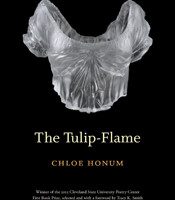Chloe Honum’s debut collection The Tulip-Flame, winner of the 2013 Cleveland State University Poetry Center First Book Prize, is a tight, finely wrought elegy focusing on the death of the speaker’s mother. But perhaps, this is too reductive a tagline. Although this central grief organizes the collection, Honum explores, on a deeper level, the way our interests—in this collection, ballet—allow us to process life’s changes. Numbering only 55 pages, the book pulls no punches, diving immediately into the tension that weaves to some degree through all the poems that follow. The book opens with the short sentence, “Mother tried to take her life,” a line illustrating the directness that marks much of the language in the collection (“Spring”).
It’s a shocking opening line that in lesser hands could pander to lurid curiosity. However, Honum is aware of this risk and mitigates it by developing the rest of the poem around descriptions of thawing icicles, windfall from the trees, and browning fruits, moving away from the mother to declare that “all that falls is caught” except for that “which has no pace to speak of” (“Spring”). Throughout the collection, she uses such description to balance plainspoken, direct statement, and her deftness in creating memorable, stark imagery is one of the book’s strongest elements. Consider the opening lines of “Dress Rehearsal” where branches “etch the film of ice / on the studio window” or “The Last of the Ballerina I Was,” which ends with a bird:
whose sudden
ascension
strands its
shadow
on the shore.
Honum also has a talent for the well-chosen simile. At the morgue, the speaker pulls on purple gloves, transforming her hands into “fish beneath the surface of a pond” (“Dressing Room”). The trees in “June in Arkansas” become “like children / walking home, asleep on their feet.” In “Visiting Hours,” love is compared to a knife “held against her [mother’s] throat.”
Most poems in the first two sections struggle with the tension that ends “Visiting Hours.” The speaker attempts to find love and understanding for her mother, who hollowly promises, after an apparent suicide attempt, that “she was happy she hadn’t died” (“Visiting Hours). In “Thirteen,” the speaker realizes that the mother “wanted to move away / from us, I knew, / and I’d have let her,” but she can’t bring herself to let her mother go. In “Alone with Mother,” the two sit in a car, “the keys a silver / starfish in her lap, silence // a kind of love between us.”
Despite the speaker’s failed attempts to hold onto her mother, there is reason to hope. In “Leaving the Hospital,” the nurses even say that the “mother…would be all right and could / come home tomorrow.” But this hope dissolves in the title poem, the emotional and literal center of the book. Buried in the middle of “The Tulip-Flame,” the speaker admits, “Last year our mother died, as was her plan.” The rest of the collection attempts to process this loss, coupling it with the dissolution of a romantic relationship and the death of a friend, and with ballet.
 Ballet becomes the speaker’s main vehicle in the collection for processing change. It reflects her confusion over her coming-of-age, her discomfort with motherhood, and her nostalgia for earlier, seemingly simpler periods of her life. Ultimately, it functions as a coping mechanism, helping the speaker process her mother’s illness. Pulling a triple pirouette feels “like disappearing” (“Ballerina at Dawn”), the stage allows her “to shape a single story, and in “Danse des Petits Cygnes,” ballet brings home the inevitability of death:
Ballet becomes the speaker’s main vehicle in the collection for processing change. It reflects her confusion over her coming-of-age, her discomfort with motherhood, and her nostalgia for earlier, seemingly simpler periods of her life. Ultimately, it functions as a coping mechanism, helping the speaker process her mother’s illness. Pulling a triple pirouette feels “like disappearing” (“Ballerina at Dawn”), the stage allows her “to shape a single story, and in “Danse des Petits Cygnes,” ballet brings home the inevitability of death:
Rehearsals ran late.
Night swayed on its green stem
and I couldn’t comprehend
we’d ever be clipped from it.
Even the style and structure of the book bring to mind ballet: poems are poised and consciously composed; the book reads light and quick—none of the poems exceed one page—but it leaves readers feeling weighted down and deeply touched by loss. This brevity and restraint allows Honum to explore her subjects while avoiding the tropes and clichés common in book-length elegies. While the poems might have benefited from more sound work (as the lines that use repetition and rhyme are some of the book’s most exciting, unexpected, and imaginative), the directness of Honum’s style serves to disarm readers and focus us more squarely on her use of image and simile.
Since most poems invoke a rain-soaked environment, share a handful of common images (birds and branches are two favorites), and revolve around the central narrative, the collection achieves a coherence and impact often missing in first books. In a debut, one expects to encounter (and forgive) missteps, an insecurity in vision, or a lack of totality or uniform polish. Readers will find none of that in this collection. The consistent clarity and strength of Honum’s writing is striking and frankly, impressive. She writes with the confidence and assuredness of a poet who has multiple books to her credit. This is a collection to read and cherish, but it also stands as a harbinger of Honum’s potential, an indication that this is only the first of what will be many more triumphs.




